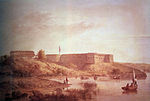Lighthouse Inn (New London, Connecticut)
Buildings and structures in New London, ConnecticutColonial Revival architecture in ConnecticutHotel buildings on the National Register of Historic Places in ConnecticutHotels in ConnecticutNational Register of Historic Places in New London County, Connecticut

The Lighthouse Inn, originally known as Meadow Court, is a Colonial Revival hotel building at 6 Guthrie Place in New London, Connecticut. The Mission style main house was designed by William Ralph Emerson and built in 1902 as a country home for steel industry magnate Charles S. Guthrie. It is one of the few examples of this architectural style in the city, and became a popular dining and event venue after opening as an inn in 1927. The building and surviving estate remnants were listed on the National Register of Historic Places in 1996. It was listed for sale by the city in February 2014, with historic preservation restrictions.
Excerpt from the Wikipedia article Lighthouse Inn (New London, Connecticut) (License: CC BY-SA 3.0, Authors, Images).Lighthouse Inn (New London, Connecticut)
Lower Boulevard, New London
Geographical coordinates (GPS) Address Nearby Places Show on map
Geographical coordinates (GPS)
| Latitude | Longitude |
|---|---|
| N 41.316666666667 ° | E -72.094166666667 ° |
Address
Lower Boulevard 248
06320 New London
United States
Open on Google Maps









